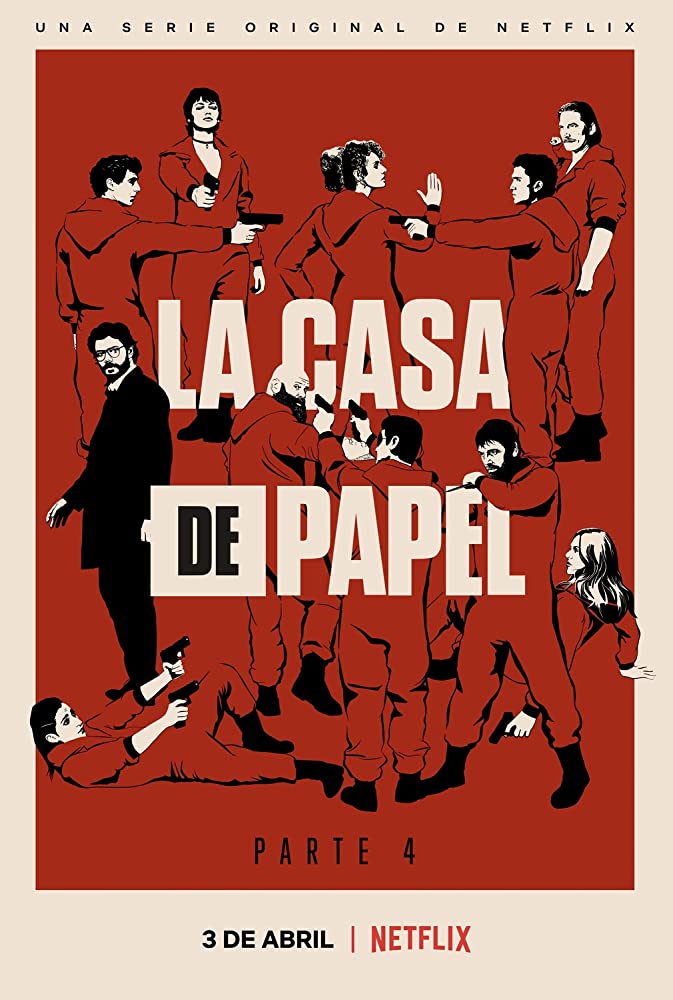La casa de papel: Netflix’s Post-Crash Thriller Returns for a Fourth Season
La casa de papel: Netflix’s Post-Crash Thriller Returns for a Fourth Season

La casa de papel / Money Heist 4
Markus Schleich (Queen’s University Belfast)
When La casa de papel first appeared on Spanish television screens on the Spanish network Antena 3 in 2017, few would have guessed that it would become a global smash hit for Netflix. Even though Netflix are quite secretive about their ratings, they have announced that La casa de papel is the streaming giant’s most-watched non-English language show worldwide. The first two seasons of La casa de papel revolve around a long-prepared, multiple-day assault on the Royal Mint of Spain. After escaping the scene with roughly 2.4 billion Euro, the gang had to commit yet another heist to free one of their captured comrades. The third and fourth season, now commissioned directly by Netflix, brings the criminals to the Bank of Spain going after the country’s gold reserves. After three seasons, the Spanish hit series is still hugely popular. After its release on April 3rd until April 5th, the fourth season has been the most watched show world-wide, according to leading global content demand analytics company for the multi-platform TV business, Parrot Analytics. The COVID-19 pandemic has driven up the demand for streamable content. It does not, however, solely explain the success of the show.
As many reviewers have remarked, it is hard to resist a heist that takes a Robin Hood-esque approach. While showcasing genre hybridization, antiheroes, and certain cinematic aesthetics, elements commonly associated with the concept of “quality tv”, La casa de papel is a vastly different breed from HBO-serials or the prestigious Nordic Noir crime shows. While most heist films are usually told with a rational male Anglo-centric focus, La casa de papel is decisively Spanish and features a female narrator, Tokyo. According to the producers, the cultural identity played an important part for the international appeal of the series, as it made the story more relatable for viewers in Spain, where the show has originally been broadcasted. By avoiding adapting the series to international demands, the show is easily distinguishable from American TV series and thereby raises international awareness for Spanish sensibilities. The emotional aspects of the show, such as the passion and impulsivity of the protagonists disrupting the perfect plan, certainly remind viewers more of telenovelas than of crime procedurals. The non-linear storytelling adds to the subversion of the heist genre. At the same time, it should be noted that La casa de papel is not universally seen as a quality show: numerous plot holes, clichéd slow-motions, unbelievable love stories and more of the like have earned the show the questionable reputation of being a highly enjoyable masterpiece of trash.

The series being set after the financial crisis of 2007–2008, which brought a time of severe austerity to Spain, many critics argued that the series was an explicit allegory of rebellion against capitalism, a revenge against the government. In one of the pivotal moments, the Professor teaches his team how people should seek to develop their own solutions for the failing capitalist system in preparation for the heist. A common theme picked up in reviews, is a Robin Hood analogy of taking from the rich and giving to the poor which arguably made it easier for viewers to connect with the show, as many Western citizens seem to currently display an obvious antipathy towards banks and politicians. La casa de papel captures the mood of Europe ten years after the crash through its Robin Hood ethos, which leads many viewers to root for the criminals, clearly described as the real heroes of the show.
This Robin Hood analogy rings somewhat hollow in the first two seasons as the criminals are actually not giving anything back to the poor but keep everything for themselves. That, however, changes in the third season, where the gang is literally showering large crowds with money. The broader population seems to be on the side of the robbers at that point as there is a large following for them when they enter the Bank of Spain, potentially seeing this new heist as a channel for the discontent of those struggling with the aftermath of the financial crash and political injustices.

It is safe to say that the most recent season of La casa de papel is its most violent yet. When the first two seasons described a circumscribed rebellion, the latter offerings have turned into a full blown insurrection against the status quo. In the final episode of season three the professor himself says: “This is no longer a heist, we’re taking down the system, this is a war.”
The extreme demand for this show and the heavily politicised discourse about it in various European internet forums, on social media, and in established mass media might be seen as an indicator that the show, for all its flaws, still appeals to a large audience for its populist agenda. Seen in the context of the new economic crisis and the political tensions provoked by the spread of the coronavirus, the show’s grim outlook might yet again capture the present mood within the European Union.

